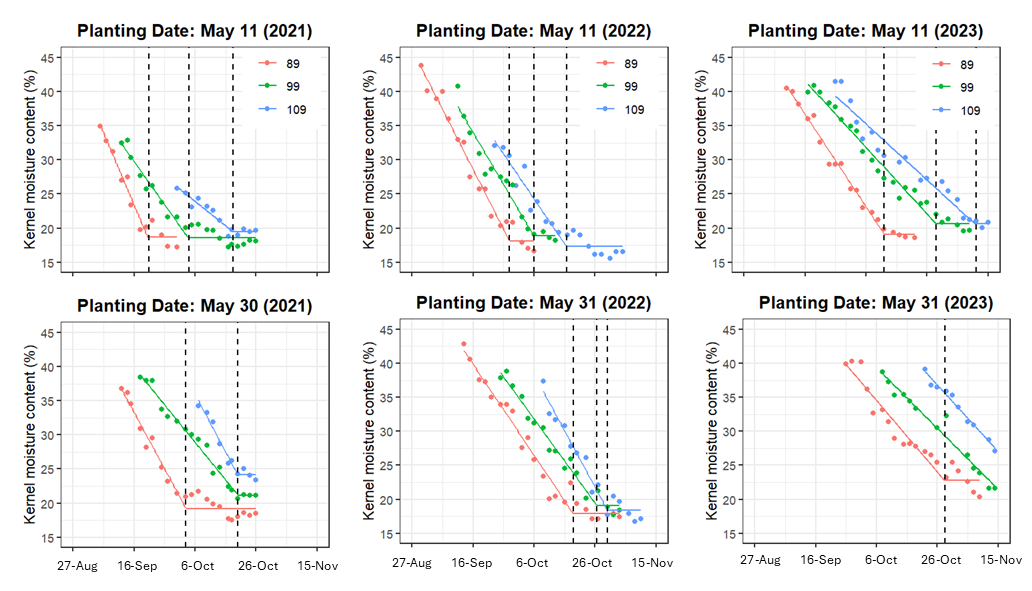Corn kernel dry down rates for Michigan
Kernel dry down rates were much higher in 2021 and 2022 but lower in 2023 due to delayed maturity and wet conditions.

Corn harvest decisions are dependent on kernel moisture content as it greatly affects drying costs (moisture price discount, drying fee and shrink factor) as well as the efficiency of harvest equipment. Therefore, obtaining sufficient in-field kernel dry down is crucial for maximum profit.
Weather elements including temperature, precipitation, solar radiation, humidity and wind greatly affect how quickly kernels dry down in the field. Other factors such as ear angle, husk leaf senescence, husk leaf thickness and tightness, and husk leaf number also play significant roles.
Typically, the rate of dry down is more rapid when favorable environmental conditions coincide with corn maturation soon after kernels reach physiological maturity or black layer stage (i.e., maximum yield). Planting time and hybrid relative maturity (RM) have an impact on how quickly corn reaches black layer stage. Early planted corn hybrids mature more rapidly than late planted, with early-maturity hybrids often reaching black layer earlier than late-maturity hybrids.
To help growers accurately estimate dry down rates and facilitate harvest decisions, we have provided data in this article for multiple corn hybrids (89, 99, 109 RM) planted early May and late May in 2021, 2022 and 2023 from field trials conducted by the Cropping Systems Agronomy lab at Michigan State University in East Lansing, Michigan.
Figure 1 shows the daily dry down pattern of the three hybrids at each planting time in 2021, 2022 and 2023. Table 1 is the summary of the daily dry down rate, the moisture content at black layer, and the plateau moisture content (beyond which additional dry down is not expected).

Overall, similar dry down patterns and rates were observed in 2021 and 2022 but differed in late May planting in 2023. The rate of dry down was numerically lower in 2023 than the other two years. Across years, dry down rate averaged 0.62% per day for 99 RM and 0.48% per day for 109 RM hybrid planted in early May. For late May planting, dry down rate averaged 0.53% per day for 99 RM and 0.71% per day for 109 RM hybrid.
In general, kernel dry down for late-planted and late-maturity hybrids reached plateau moisture content by late October in 2021 and 2022 but did not reach plateau in 2023. Plateau moisture content is the kernel moisture beyond which no considerable amount of additional dry down occurs. In 2021, plateau moisture content for late-planted hybrids was greater than 20% and we did not observe additional dry down due to lack of favorable environmental conditions (persistent cool, wet weather in 2021), hence final harvested corn was greater than 5% above the 15.5% threshold and probably reduced profits. In 2022, plateau moisture content was much lower (around 18%) and a period of abnormally warm and dry weather in early November provided extra drying with final harvest moisture around 16%. In 2023, moisture did not plateau for 99 and 109 RM at late May planting due to abnormally wet conditions in October and early November resulting in high harvest moisture in some fields.
|
Table 1. Daily kernel dry down rates for two hybrids (99 and 109 relative maturity, RM) planted around May 10 and May 30 during 2021, 2022 and 2023 growing seasons in East Lansing. Moisture at black layer is the kernel moisture content at the time of black layer (i.e., maximum yield). Moisture at plateau is the kernel moisture content beyond which significant additional dry down is not expected. Data range for moisture at black layer and plateau is across hybrids and planting times. |
|||
|---|---|---|---|
|
Variable |
Year |
||
|
2021 |
2022 |
2023 |
|
|
Daily dry down rate; 99 RM, May 10 planting |
0.63% |
0.76% |
0.47% |
|
Daily dry down rate; 99 RM, May 30 planting |
0.55% |
0.59% |
0.44% |
|
Daily dry down rate; 109 RM, May 10 planting |
0.36% |
0.66% |
0.41% |
|
Daily dry down rate; 109 RM, May 30 planting |
0.84% |
0.83% |
0.47% |
|
Moisture at black layer |
28 - 32% |
28 - 39% |
|
|
Moisture at plateau |
16 - 24% |
19 - none* |
|
*Moisture did not plateau for 99 and 109 RM planted in late May.
What number should you use to estimate dry down this year?
Michigan State University Extension recommends using the average dry down rates of the three years that we have shown to estimate how quickly corn will dry down this year. Given the distinct differences among weather conditions across the three years, we believe an average of these dry down rates captures all the extreme scenarios. This would mean a rate of 0.62% for early May plantings and 0.53% for late May plantings for typically hybrid maturity (99 RM) in central Michigan. Recent dry and warm conditions across the state are resulting in faster corn maturity and current dry down rates in mature corn are probably close to our recorded peak rate (0.8% per day).



 Print
Print Email
Email